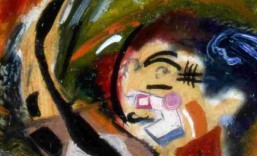Why does it seem that the most successful people are the biggest assholes? Latest example being Kehinde Wiley, the portraitist credited with painting Obama in 2018, who is accused by at least three people of sexual abuse and inappropriate touching. In other words, abusing his position as a prominent artist – which doesn’t seem like an isolated story given Chuck Close, Pollock, Rivera, Picasso, Gauguin – the list is long even when limited to famous visual artists. That he is being accused of abuse is not surprising seeing as Wiley is firstly a capitalist taking advantage of others – and a prime follower of today’s unfortunate art world successful artist trend of being mainly an art manager and marketer who seeks to exploit others for personal gain – in this case mainly Chinese artisans, who execute his works a la Koons or Warhol. He is an adherent to the modern principle of the “artist” not showing presence in their work and only being the ‘conceptual’ master behind the images he mass produces, markets and sells. And sure enough his ‘hand’ is invisible because he plagiarizes images from old masters then has his assistant(s) photograph ‘street’ people in the same pose and superimposes this over a decorative pattern also probably appropriated but definitely not executed by him. Kind of like having others manifest a photoshop collage you put together except in boring repetition. But hey it sells, right? Not my idea of art but it is definitely accepted today as legitimate. The National Coalition Against Censorship (NCAC) jumped into the fray to defend the abusive asshole because several museums and galleries cancelled their exhibits of his work over the issue. For their part a group of those abused by the artist put out a joint statement saying that “…artistic merit, while significant, should not take precedence over issues of moral injury and human dignity.” I agree, at least as long as Wiley is alive and continues abusing his position of privilege it is only justice to deny him exhibit space by those professing an aversion to moral turpitude. Once he is gone, history may patiently pass judgement on whether the value of Wiley’s art, in the context of art history, surpasses the stain of his personal conduct. After all, many of the abusive artists mentioned here earlier who have passed away still hang prominently in major museums all over the world in spite of their conduct.
Category Archives: Technology and Art
The Artbots start to take over
About four years ago I was part of a pioneering group that typed text to create pictures using a catalog of images and textures. It was a clumsy and tedious process that produced strikingly similar work and ultimately held my interest for only a short time. But technology moves fast. The past year has seen a proliferation of sophisticated artificial intelligence (AI) text-to-image programs that will blow your mind and make you worry about the future of artists. Illustrators and graphic artists may as well surrender their aspirations or learn to code. Online programs such as Stable Diffusion, Dall-e 2, Wombo, Pixray, Canva, Starryai and others create art out of words better than any stable of Chinese slave artists I have ever tried to liberate. Any style, any topic – the variety and sophistication of the art is incredible. These are no longer just simple art filters (Texture, ‘Watercolor’, Pixelate etc.) included in popular graphics programs like Adobe Photoshop or Corel Draw and ‘mapped’ over personal images or photographs… these are full art styles applied to an image derived solely from a written description. Nor are they popular app filters like Pixma, Toonme, or Deep Art Effects, that need you to provide a base photograph or image to apply their styles – just words will do. Much has been made of a prize won by an AI-generated ‘photograph’ this past August in Texas but the distinction between human and computer creativity has never been thinner, and more examples are bound to arise – that is if they are revealed, because there is little to distinguish one from the other. Of course these text-to-image programs rely (like my prior experience) on a database of visual images created in the past by human artists – but the variety derived from this trove is unique to the text proposed and the genesis of the image is generally hidden from the author. Technology has their bots recycling old art but seems incapable of creating new movements or aesthetics like groups of artists have in the past. Of course nowadays many artists cycle between past styles and ‘appropriate’ images from other artists with impunity – and in doing so erase acceptance of the same from artificial intelligence. It seems contemporary art is presently stuck in a vicious circle of refinement and regurgitation. Meanwhile, the bots match our most famous examples in the visual arts… and from the fringes wear down and corrupt the inspiration of emerging artists and any originality they can dream of inventing.
